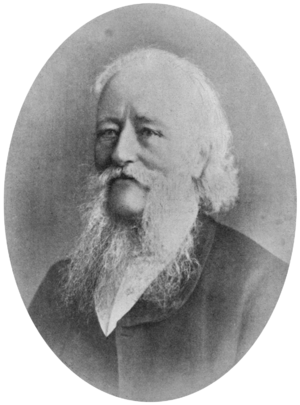William Colenso facts for kids
Quick facts for kids
William Colenso
|
|
|---|---|

William Colenso, 1898
|
|
| Born | 17 November 1811 |
| Died | 10 February 1899 (aged 87) |
| Occupation | Missionary |
| Spouse(s) | Elizabeth Fairburn (married 1843) |
William Colenso (born November 17, 1811 – died February 10, 1899) was an important person in New Zealand history. He was a Christian missionary from Cornwall, England. He was also a printer, a scientist who studied plants (a botanist), an explorer, and a politician.
Colenso was present when the Treaty of Waitangi was signed. This was a very important agreement between the Māori people and the British Crown. He later wrote about what happened at Waitangi.
Contents
William Colenso's Early Life
William Colenso was born in Penzance, Cornwall, England. His family name, Colenso, comes from a place near Penzance.
He learned to be a printer's apprentice. This means he learned how to set type and print books. In 1834, he traveled to New Zealand to work for the Church Mission Society. He was a printer and a missionary.
Printing the First Māori Bible
William Colenso played a huge role in printing the Māori language translation of the New Testament. This happened in 1837. It was the first book ever printed in New Zealand. It was also the first time the Bible was translated into an indigenous language and published in the southern half of the world.
By July 1837, he had printed many copies of parts of the Bible. He also printed tables for schools, like addition and multiplication charts. By 1840, he had printed thousands of religious texts and school materials. He even printed copies of the New Zealand Gazette, which was a newspaper for the government.
Colenso and the Treaty of Waitangi
On February 5, 1840, Colenso was at Waitangi. He wrote down and translated what the Māori chiefs (called rangatira) were saying. They were discussing the Treaty of Waitangi (Te Tiriti o Waitangi).
Before the treaty was signed the next day, Colenso asked for an important part to be added in writing. This part, called Article Four, had been agreed upon verbally.
Exploring New Zealand's Nature
Colenso loved studying plants. He was a very keen botanist. He found many new kinds of New Zealand plants. He sent details and samples of these plants to Kew Gardens in England.
He helped another famous botanist, Joseph Dalton Hooker, who visited New Zealand in 1841. In 1866, William Colenso became the first New Zealander to be chosen as a Fellow of the Royal Society. This is a very high honor for scientists. He wrote many books and over a hundred scientific papers.
Journeys Across the North Island
In the 1840s, Colenso made many long journeys. He traveled through the central North Island of New Zealand. He went with Māori guides. His goal was to visit Māori settlements inland and share Christianity.
His travels took him through thick forests and over the high Ruahine Range. He crossed the Rangipo Desert and went past mountains like Ruapehu and Tongariro. He even reached the shores of Lake Taupō. He used existing Māori paths, which helped Europeans explore the central North Island. One of his journeys in 1841-1842 went all the way across the North Island to the Kaipara Harbour.
A Life in Politics
After some personal challenges, William Colenso became active in local politics in Napier. He was elected as a Member of Parliament for the Napier electorate. He served from 1861 to 1866.
| New Zealand Parliament | ||||
| Years | Term | Electorate | Party | |
| 1861–1866 | 3rd | Napier | Independent | |
In 1871, Colenso was the speaker at the Hawkes Bay Provincial Council. At this time, a group of Māori from Ngati Kahungunu were trying to get their land back. This was part of a movement called the Repudiation Movement. Colenso advised Māori not to take a legal path that might lead to debt.
William Colenso passed away in Napier in 1899. He left behind two sons and a daughter.
Remembering William Colenso
Many plant species have been named in honor of William Colenso. One example is Acrothamnus colensoi.
Colenso Society
The Colenso Society was started in 2010. It includes academics and historians from New Zealand. The society's goal is to learn more about the life and work of William Colenso.
Images for kids




